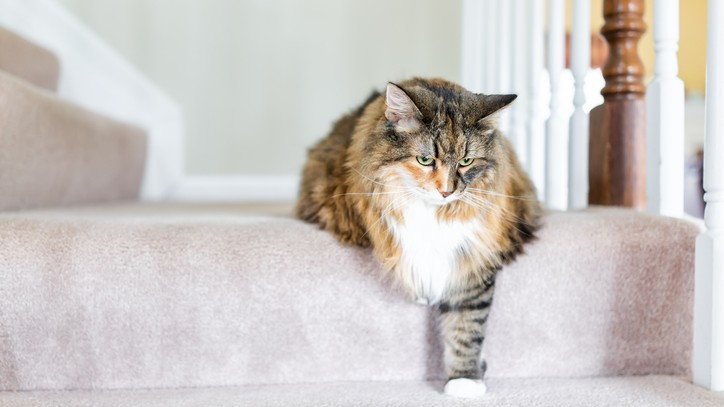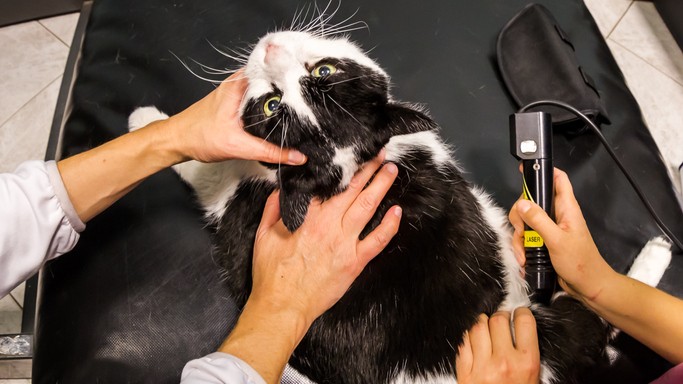A vet's guide to Osteoarthritis in cats
Osteoarthritis in cats is underdiagnosed and undertreated. Would you recognize the signs of painful arthritis in your cat?

Vets and owners often miss the signs of osteoarthritis in cats. X-rays of cat joints show that up to 90% of cats have arthritic joints, but that less than half might be being diagnosed. This is because the signs of arthritis in cats are subtle and their stress in the clinic means a meaningful examination is difficult. This means that spotting the signs of feline arthritis is down to the pet parent – so let’s look at what arthritis is, and how to spot the symptoms in your cat.
- How to treat urinary tract infections in cats
- 11 things to check when your cat’s not eating
- Seven common cat behavior problems solved
What is osteoarthritis in cats?
Osteoarthritis (commonly called ‘arthritis’) is a painful joint condition that develops, and gets worse, over time. Where bones meet in a joint, a combination of smooth cartilage and slippery joint fluid mean the bones should glide easily over one another.
With injury or a lifetime of wear-and-tear, the cartilage becomes damaged, and less fluid is produced, causing a grinding of bone on bone. This sets off pain signals and inflammation, which in turn further damage the joint. Every time an arthritic joint is moved, it is painful. It may not be able to bend as far (called a ‘reduced range of motion/movement’ or ‘ROM’) and may be stiff.
In cats, the elbows and hips are the most commonly affected joints, but any joint can be affected. It’s also common for arthritis to affect two or more joints – both elbows, for instance. Whilst around 70% of cases are ‘primary’ arthritis, caused by age, obesity, wear and tear, and other unknown causes, the remaining 30% have a likely cause, such as a known injury to the joint.
What are the signs of osteoarthritis in cats?
Cats are prey creatures, and like most prey species they hide pain very well. It would be extremely rare to see a cat limping with arthritis, or to hear them cry out – mostly, they’ll just put up with it and adjust their lifestyle to allow for the pain and reduced range of motion. So, what can you, as a pet owner, look for?
- Sleeping more/increased time resting
- Changes in the ability to jump, or a reluctance to jump
- Changes in the height of jump (and missing jumps)
- Unkempt coat and reduction in grooming behaviours
- Toileting outside the litter tray
- Changes in gait – especially noticeable on the stairs
- Moodiness, decreased playfulness, and withdrawal
Osteoarthritis in Cats: Diagnosis

There’s no NHS for pets. Veterinary care can be eye-wateringly expensive and most pets will need treatment for an illness or injury at some point in their life. It’s difficult to think about your animals being hurt or unwell, but you need to ask yourself: what would you do if you were faced with a vet bill for hundreds or thousands of pounds?
Because osteoarthritis in cats is so subtle, many cases go undiagnosed. If you suspect your cat has arthritis, book an appointment with your vet. They’ll try to examine your cat, but it’s likely that ‘white coat syndrome’ will make diagnosis difficult. Blood tests may be recommended, both to rule out other causes of symptoms and to ensure the safety of any treatment recommendations. X-rays may also be recommended, especially if your cat is unusually young for arthritis.
However, most diagnoses of arthritis in cats rely on your observations. Questionnaires called ‘Clinical Metrology Instruments’ or ‘CMIs’ can help you to rate symptoms and their severity. Many of the common options, like the Feline Musculoskeletal Pain Index, have been assessed and validated using studies. These can help to diagnose arthritis, and also to assess response to treatment.
Sometimes, a ‘trial treatment’ helps with diagnosis. This involves giving pain relief for a week or two, and then assessing the response. If the symptoms improve, the cat was painful and will need treating long-term. Sometimes, removing the pain relief at the end of this period causes an obvious recurrence in symptoms, which cements the diagnosis.
Treatment for osteoarthritis in Cats
Arthritis causes chronic pain, and it needs treating for welfare reasons. Remember, as they hide the signs so well, many cats are in more pain than they let on – and this can make choosing the appropriate level of treatment difficult. Treating osteoarthritis in cats often requires a trial-and-error approach. Using many different options together generally results in better pain relief with fewer side effects.
Non-steroidal anti-inflammatory drugs (NSAIDs)
NSAIDs are the mainstay of arthritis therapy for cats, dogs, and humans. These drugs work by reducing inflammation in the joints, and therefore reducing pain. NSAIDs may be given once daily, twice daily, or as needed, depending on the formulation and individual case – but it’s important to remember that ‘as needed’ can be difficult to determine in cats. Older NSAIDs produced side effects in some cats. Whilst newer generations of drugs have reduced these, vets still recommend monitoring the kidneys in old cats using regular NSAIDs.
NSAIDs can only be purchased with a prescription, but once your cat is on it long-term, you can ask your vet to produce a written prescription to be filled at any pharmacy, including online pharmacies.
Joint supplements
Joint supplements are designed to increase the levels of various nutrients thought to be important to joint health. Glucosamine, chrondroitin and Omega-3s are common ingredients, but you may also find combinations of turmeric, MSM, green lipped mussels, and avocado-soybean unsaponifiables (ASUs). Joint supplements are not heavily regulated so can vary wildly in composition, palatability, and price – but your vet will be able to help. These non-prescription products are rarely enough to remove the pain of arthritis on their own, but they might reduce the dose of NSAIDs you need to give.

Laser, physiotherapy, and acupuncture
Depending on your cat, you may want to try laser therapy, physiotherapy, and/or acupuncture, all of which can help with the symptoms of arthritis. Many vet practices offer laser, but they may have to refer you to a physiotherapist that will deal with cats. Acupuncture can only be carried out by a veterinary surgeon in the UK – you can use this website to find a vet that practices acupuncture near you.
Conclusion
Diagnosing osteoarthritis in cats can be difficult, as they’re excellent at hiding the signs. But it causes chronic pain and is a big welfare problem. As vets, we rely on you spotting the signs of arthritis at home. If you think something’s up, talk to your vet – even if nothing can be found on examination they’ll suggest a way to help make a diagnosis. Arthritis treatment usually involves daily medication, but adding in alternative therapies can help.
PetsRadar Newsletter
Get the best advice, tips and top tech for your beloved Pets
After graduating as a vet from the University of Nottingham, Dr Joanna Woodnutt went on to practice companion animal medicine in the Midlands. Since then, she has also written for countless online and print publications and is a regular contributor for Edition Dog Magazine.

